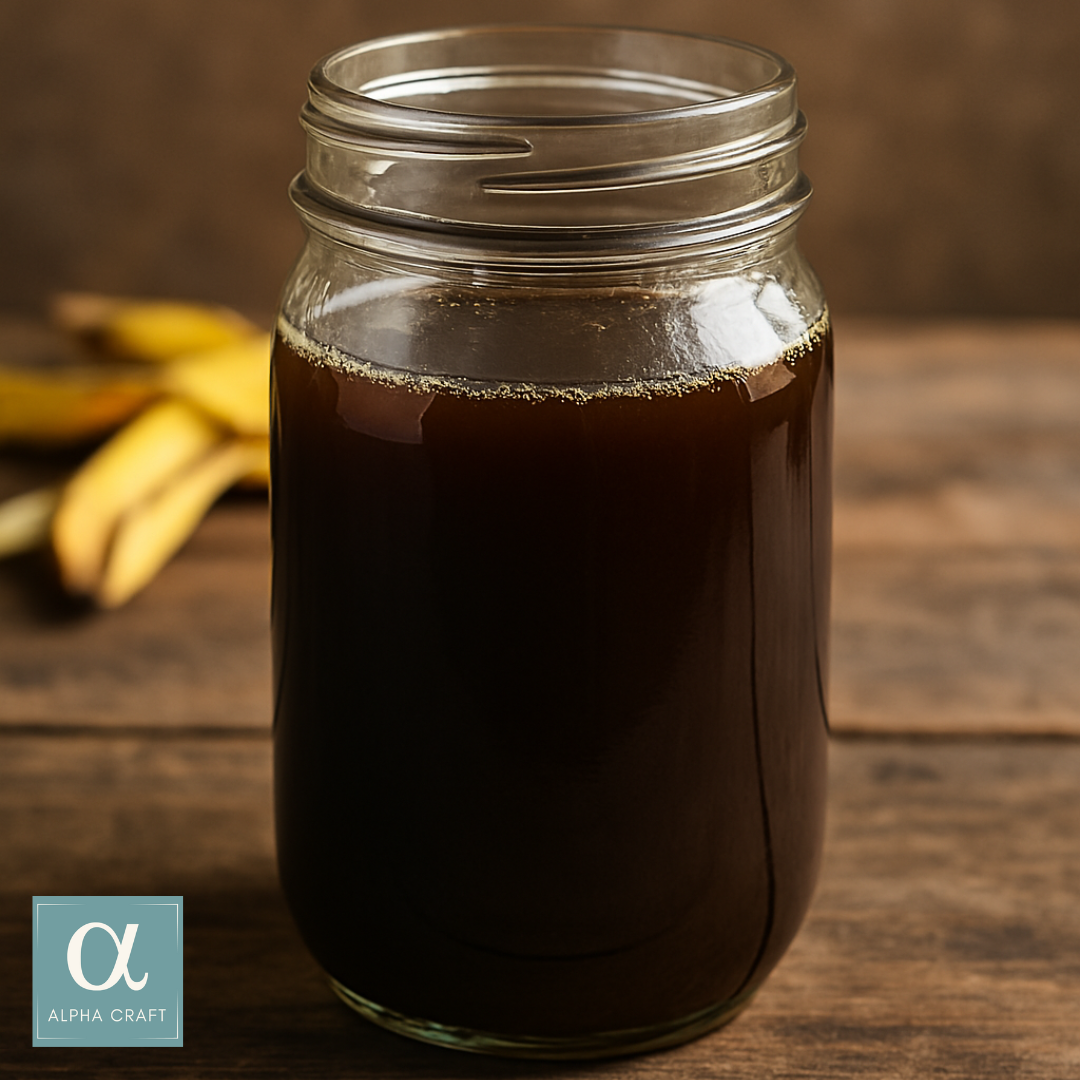Banana Peel Fertilizer
Transform leftover banana peels into a nutrient-rich fertilizer that promotes strong roots, vibrant blooms, and healthy foliage. Packed with potassium, phosphorus, and calcium, this easy homemade solution is perfect for flowering and fruiting plants.

Inventory
Some of the links in this post are affiliate links, and we may receive a commission if you purchase through them.
Tools & Equipment
- Blender or Coffee Grinder
- Baking Sheet
- 6-quart Stock Pot
- Fine Mesh Strainer
- Spray Bottle
- Mason Jar for storage
Ingredients
- Banana Peels (organic only)
- Water
Instructions
Method #1: Banana Peel Tea
It provides gentle, slow-release nutrients that plants easily absorb. Great for regular water routines.
Prepare the Peels
Cut the banana peels into small pieces.
Boil the Peels
Fill a pot with 4 cups of water and bring to a boil. Add the banana peels and boil for 10-15 minutes. Let it cool and then strain out the peels. Discard the peels in the compost.
Alternatively, soak the peels in cold water for 2-3 days.
Application
Dilute with equal parts water before use. Apply to plants by watering the soil or spraying on leaves. Use every 1-2 weeks during the growing season.
Storage: Pour the liquid into a jar or spray bottle and store it in the fridge for up to one week.
Method #2: Blended Banana Peel Fertilizer
It provides a quick nutrient boost with high potassium, phosphorus, and trace minerals, promoting root and flower development. It is easy to make and use.
Blend the Peels
Add 3-5 peels and 2 cups of water to a blender. Blend until smooth.
Strain
Pour the blended mixture through a fine mesh strainer.
Application
Dilute the liquid with 3-5 parts water to 1 part fertilizer before using.
Dilution protects plants from root burn and helps the nutrients penetrate the soil more effectively.
Storage: Store in an airtight container in the fridge for 1-2 weeks or freeze for up to 3 months.
Method #3: Banana Peel Powder
This most potent method boosts microbial activity and nutrient availability by adding a long-lasting and powerful nutrient source.
Dry the Peels
Preheat the oven to 200°F (90°C). Arrange the banana peels in a single layer on a baking sheet. Bake for 4-6 hours or until the peels are crispy and brittle. Turn them occasionally to ensure even drying.
Alternatively, set the dehydrator to 135°F (57°C) and dry for 8-12 hours or until completely dry and crumbly.
Grind the Peels
Grind the banana peels in a coffee grinder or blender until they are a fine powder. Sift the powder to remove larger chunks and regrind if needed.
Application
Sprinkle at the base around plants and mix into soil or sprinkle powder directly into the compost pile to enhance potassium and phosphorus content.
Storage: Transfer the powder to an airtight container. Label it with the date and contents. Store in a cool, dry place, and it will last for up to 1 year.
Method #4: Fermented Banana Peel Fertilizer
Easy to store and use, provides slow and steady release of potassium, phosphorus, and calcium.
Prepare the Peels
Chop the peels into small pieces and place them in a jar. Add 1 tbsp of sugar to jumpstart fermentation.
Ferment the Peels
Cover the jar loosely and let it sit in a warm spot for 1-2 weeks. Stir occasionally to release gases.
Strain the Peels
Strain out the solids with a fine mesh strainer and dilute with 10 parts water to 1 part fermented liquid.
Application
Apply directly to the soil at the base of plants as a soil drench or as a foliar spray on the undersides of leaves.
A soil drench is best for root absorption, while a foliar spray allows for quick nutrient uptake for struggling plants. Spray in early morning or late evening to avoid scorching from the sun.
Storage: Store sealed in an airtight container at room temperature in a dark place for 3-6 months or refrigerated for up to 1 year.
Banana peel fertilizer is rich in potassium, phosphorus, calcium, and trace minerals, making it great for flowering and fruiting plants. However, its benefits will be maximized by using it at the right time and in the right situations.
Signs of Deficiencies
Potassium Deficiency | Yellowing or browning at leaf edges, Weak stems, poor flowering or fruiting.
Plants at risk are tomatoes, peppers, flowering perennials, and fruiting trees.
Phosphorus Deficiency | Purplish or dark green leaves, stunted growth or poor root development, reduced fruit or flower production.
Plants at risk are fruiting vegetables, root crops, and flowering plants.
Calcium Deficiency | Blossom-end rot on tomatoes and peppers, deformed or curled leaves, bitter pit in apples.
Plants at risk are tomatoes, peppers, eggplants, and fruit trees.
Potassium and phosphorus assist in flowering and fruiting, so adding this fertilizer during these stages will help in these activities.
Modifications
Add Magnesium & Sulfur
Magnesium and sulfur help improve chlorophyll production and enzyme function, promoting greener foliage and healthy blooms. Add 1 tbsp Epsom salt per quart of blended or fermented banana peel liquid.
Balance it with Nitrogen
Since banana peels lack nitrogen, adding a nitrogen source creates a more balanced fertilizer. You can do this by adding 1-2 tbsp coffee grounds to liquid or use in conjunction with powder.
Every craft begins as an alpha craft. Crafts are developed by considering the function and effect of inputs and all the actions needed to create the transformation. They are designed with theory and research but have not been personally tested by any Guild Craft Trade employee or member. When you perform a craft at this stage, it is through your own experimentation (and risk, if there is any).
This designation is part of our mission to build a chain of production for cottage industry. To learn more, see our About page.